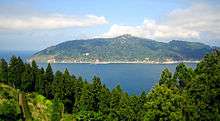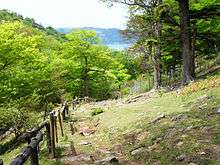Kinkasan
Kinkasan (金華山; also Kinkazan) is a small mountainous island at the tip of the Oshika Peninsula, not far from Sendai in Tohoku, Ishinomaki, Japan.

Understand
Literally meaning "Golden Flower Mountain", its spiritual significance and the fact that the island used to be a site for a brief gold prospecting boom ensure a steady stream of visitors eager for some good fortune to rub off. Kinkasan is considered one of the three holiest places in Tohoku region, along with Dewa Sanzan and Osorezan. Today little remains except an impressive Shinto shrine devoted to the gods of wealth, Ebisu and Daikoku. Women were actually banned on the island until the late 19th century, but today, for both sexes, an overnight stay is ideal for those seeking tranquility. According to legend, if you pay a visit to the shrine once a year for three consecutive years, you will have no financial difficulties for the rest of your life.
Get in
Kinkasan being an island, you'll have to take a ferry at some point, so the main question is choosing the ferry terminal.
By train
If traveling by train from Sendai, take the JR Senseki line to Ishinomaki, then change to the JR Ishinomaki line for Onagawa. From here, you can take a 35-minute ferry to Kinkasan. Ferries travel every 2 hours or so and cost ¥1,600 one way, ¥3,040 return.
By bus
Alternatively, you can take a 90-minute bus from Ishinomaki to the whaling town of Ayukawa, from where ferries ply to Kinkasan in 20 minutes (¥900). Services from here are more frequent, as often as every half hour in season with two competing operators.
Get around
Excluding a van ferrying guests up from the ferry to the shrine's ryokan, there is no motorized transport on the island, so you'll have to walk. Some ferry operators in Ayukawa offer sightseeing boat tours around the island, but there are no other points to disembark.
See
- 🌍 Koganeyama Shrine (黄金山神社) (Up the hill 600 meters away from the ferry terminal.). This shrine is the reason most Japanese come here. The shrine originally dates to the 8th century, However a major fire destroyed most of the buidings during the Meiji period. Following that a team of hundreds of woodworkers were brought to the Island, where they spent 15 years building one of the most exquisitely carved pavilions in Japan. Legend has it that those who visit the shrine three years in a row will become rich.
Do

Perhaps a better reason to visit is some fairly good hiking. Major trails head from the shrine to the summit (height 445m, distance 2.4 km) and around the entire island (around 25 km). With some luck you can spot Japanese macaques (Macaca fuscata), troops of which roam about the island. Pick up a free map and leave plenty of time before you set off though, as the trails are not that well marked; if you get hopelessly lost, head down to the coastal trail.
Buy, Eat & Drink
- The shrine maintains a monopoly on food, drink and souvenirs on the island. Prices are not unreasonable, and many try the seafood here (yes, whale is also available).
Sleep
Many visitors stay in nearby Ayukawa, though there are lodging options here.
- Koganeyama Jinja Sanshuden (黄金山神社参集殿), ☎ +81 225-45-2301. A pilgrim's lodge operated by the shrine, is the sole accommodation choice on the island itself. The lodge is a large and impersonal five-story concrete building, but rooms are Japanese style with tatami and partly redeemed by the gigantic steel bathtub downstairs. 1 night and 2 meals ¥10,000.
Stay safe
There are two endemic pests on the island: deer and leeches, both of which want to eat things you'd rather keep to yourself. When hiking, keep your trousers stuffed in your boots, and if you do spot leeches remember to use salt or fire to dislodge them, not brute force. Absolutely do not try to feed the deer or the monkeys.